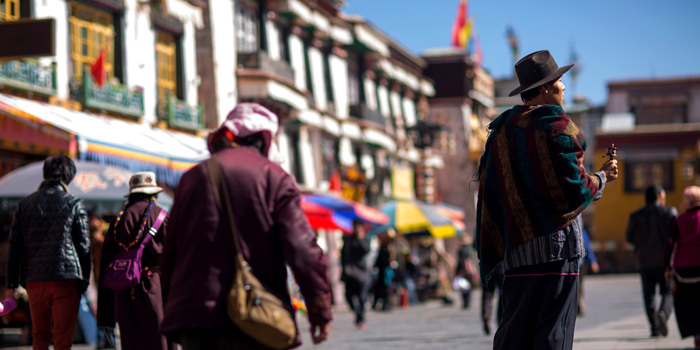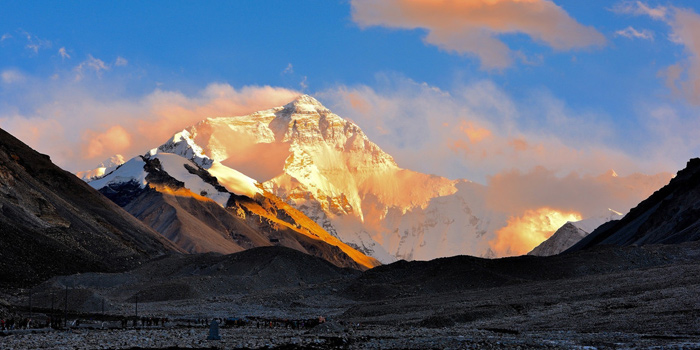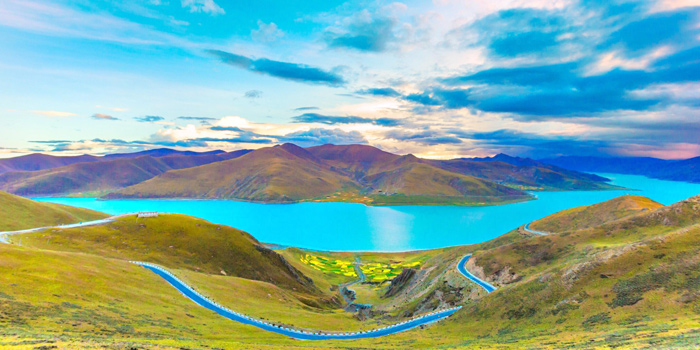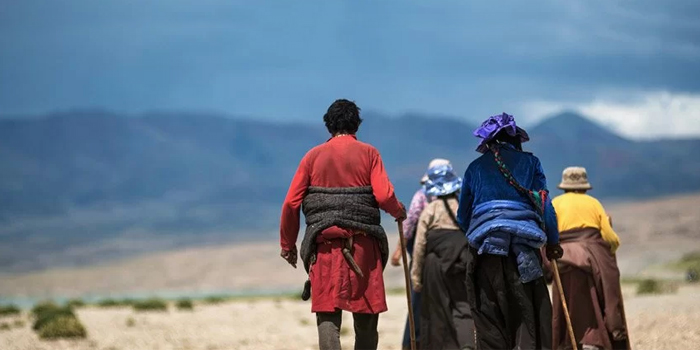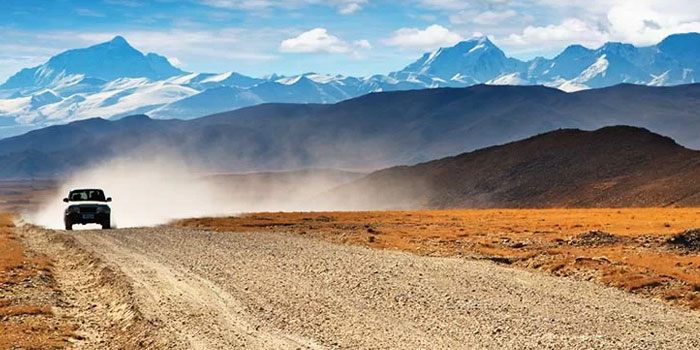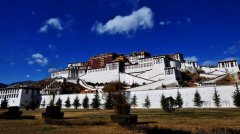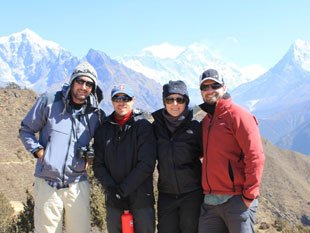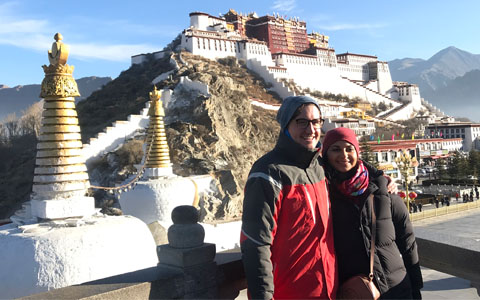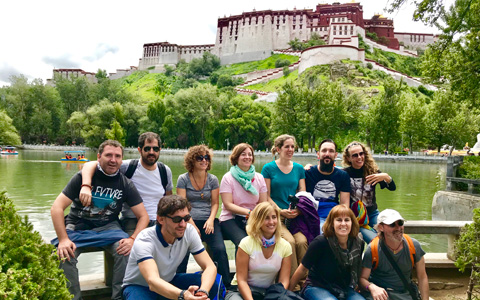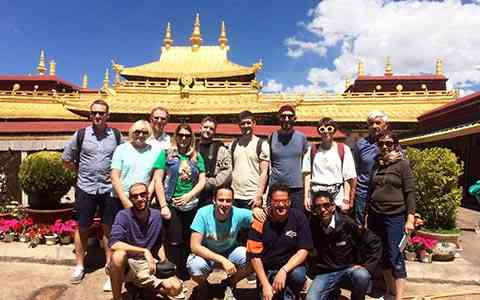Tibet Snow: when it snows usually? how to plan a trip to enjoy snow in Tibet?
Winter in Tibet is the time for snow in the higher areas of the region. There is a unique and quaint charm to Tibet in the winter, with beautiful snow scenes and clear, bright skies. It is still possible to visit Tibet in the winter, and it is really not as cold as many people think. While it can get down to well below freezing at night, the days can be warm enough, with the bright sun in this thin atmosphere making the air feel warmer than the altitude would suggest.
Winter is also the low season in Tibet and means that there are normally fewer tourists and travelers on the plateau, which gives rise to some decent discounts as well. So, if it is the snow scene that you are looking for, then coming to Tibet in winter is almost guaranteed to find you snow somewhere on this vast plateau.
 When Does It Usually Snow in Tibet? (November to April)
When Does It Usually Snow in Tibet? (November to April)
 Where to Enjoy Snow in Tibet for a Winter Tour?
Where to Enjoy Snow in Tibet for a Winter Tour?
 Top Tibetan Snow Mountains to See the Snow All Year Round
Top Tibetan Snow Mountains to See the Snow All Year Round
 Recommended Tibet Tour Itineraries to Enjoy the Snow in Tibet
Recommended Tibet Tour Itineraries to Enjoy the Snow in Tibet
 More Travel Tips for Enjoying Snow in Tibet when Visiting Tibet
More Travel Tips for Enjoying Snow in Tibet when Visiting Tibet
When Does It Usually Snow in Tibet? (November to April)
Winter is the time for snow anywhere in the world that has a temperate climate, and Tibet is no exception. For some areas of the region, the snows can start falling as early as November, and can last until April and the coming of spring.
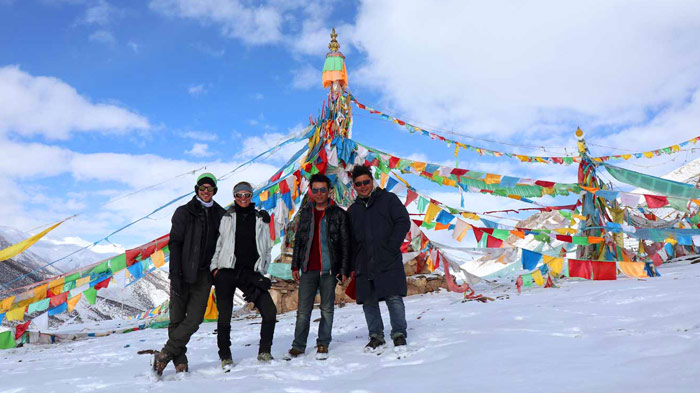 Snow scenery of Tibet.
Snow scenery of Tibet.
Winter in Tibet is not all freezing cold and inhospitable, and there are areas that have warmer weather even in November and December. But for the snow scenes, it is best to travel to the higher altitude areas of Tibet such as Mount Everest region and Namtso Lake in Ngachu, where there is more chance of seeing snow in the early part of winter.
And while there may be snowy landscapes in some areas of Tibet, that does not mean they are inaccessible. Even Mount Everest can be seen in the winter months, until a heavy snowfall makes it impossible to get over the high passes on the route to the famous mountain.
Is Lhasa snow in winter?
Lhasa experiences occasional light snowfall in winter, with the possibility of no snow at all. Winter temperatures in Lhasa can range from around -9°C (16°F) to 7°C (45°F).
While the city may not be adorned in heavy snow, the western regions of Tibet, especially in winter, showcase a picturesque landscape blanketed in thick layers of dazzling white snow. For those seeking a more robust snowy experience, areas beyond Lhasa offer a captivating alternative.
Where to Enjoy Snow in Tibet for a Winter Tour?
Tibet, with its stunning landscapes, offers a unique winter experience for travelers seeking to immerse themselves in a snowy wonderland. The central and western regions of Tibet are the prime destinations to savor the beauty of snow during winter. Here, the landscape transforms into a mesmerizing white canvas, dotted with snow-capped mountains, pristine valleys, and frozen lakes.
One of the most iconic places to revel in the snow in Tibet is Everest Base Camp. The Everest Base Camp in Tibet is not only a popular destination among tourists in the summer, but it also becomes an enchanting winter wonderland during the colder months. The mighty Mount Everest stands tall against a backdrop of sparkling white snow, creating a breathtaking sight that's accessible in winter, provided you're well-prepared for the cold.
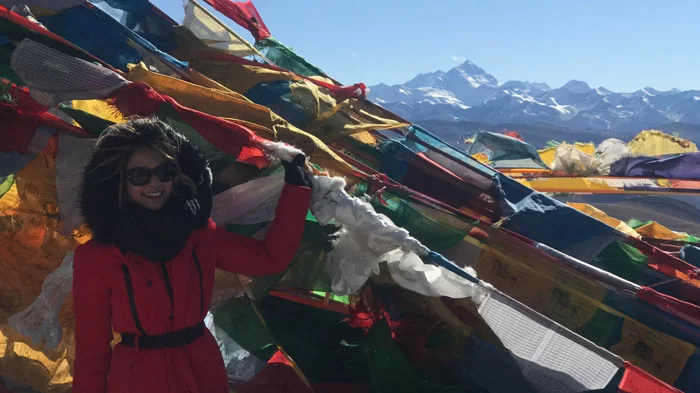 Visit Mount Everest in Tibet Gawula Pass.
Visit Mount Everest in Tibet Gawula Pass.
For those who prefer a more comfortable winter experience, Lhasa and its surrounding areas offer a late winter tour option. The snow in and around Lhasa is not as intense as in the western regions, making it a milder and more accessible choice for a snowy getaway.
Friendly reminder:
However, it's essential to note that in late winter, many mountain areas and remote destinations in Tibet may be closed due to heavy snowfall. So, plan your Tibet tour accordingly and check for local travel advisories to ensure a safe and enjoyable winter adventure in Tibet.
Top Tibetan Snow Mountains to See the Snow All Year Round
Snow Mountains are a feature of the Tibetan Plateau and can be seen in many areas of Tibet as well as the areas of Yunnan and Sichuan that lie on the Tibetan Plateau. A Snow Mountain in Tibet is one of the high mountains that has snow on it all year round, instead of just a clear summit. These mountains are often places of holy worship, and are sacred in Buddhism, believed to be the abodes of the gods.
Mount Everest at the Border between China and Nepal
Located at the southern border between China and Nepal, Mt. Everest in Shigatse is renowned for its snow-clad peaks and iconic status as the world's highest mountain. Accessible through an overland trip from Lhasa, it offers a stunning scene at Everest Base Camp, showcasing pristine white snow and majestic landscapes.
Mount Kailash in the Far West Ngari Region
Situated in Ngari Region, far west Tibet, Mt. Kailash is the most sacred snow mountain in Tibet. It is known as the center of world by four religions. One of the mysteries of Mount Kailash is that the snow on the top is never melt.
The Mount Kailash trek, available from mid-April to mid-Oct, provides a breathtaking adventure amid snow-covered landscapes. Journeys to Mt. Kailash can take 15 days from Lhasa or 10 days from Kathmandu.
Nyenchen Tanglha Mountains surrounding Lake Namtso
Nyenchen Tanglha Mountain stands majestically as a guardian of Lake Namtso, one of the holiest lakes in Tibet. This awe-inspiring mountain range is renowned for its towering peaks, pristine glaciers, and spiritual significance in Tibetan culture. Lake Namtso, cradled within this majestic embrace, glistens with crystalline waters, offering a serene and breathtaking natural wonder.
When you visit Lake Namtso, you can admire the beautiful sight of the huge lake surrounded by endless snowy mountains while standing on the lakeshore.
 The snow-capped Nyenchen Tanglha Mountains and Lake Namtso
The snow-capped Nyenchen Tanglha Mountains and Lake Namtso
Mount Nojin Kangtsang near Lake Yamdrok
Mount Nojin Kangtsang, near Lake Yamdrok in Tibet, is a towering peak that reaches for the skies, perpetually covered in snow. It's an important part of the Transhimalaya range and holds deep spiritual significance for the locals.
Near the mountain peak, is the famous Karola Glacier at the Karola Pass. It is a striking ice formation that stretches down the slopes. It's a vital source of freshwater for the region, offering both beauty and sustenance to the surrounding landscapes.
If you are interested in visiting Karola Glacier, you can pay a short visit after your trip to Yamdrok Lake.
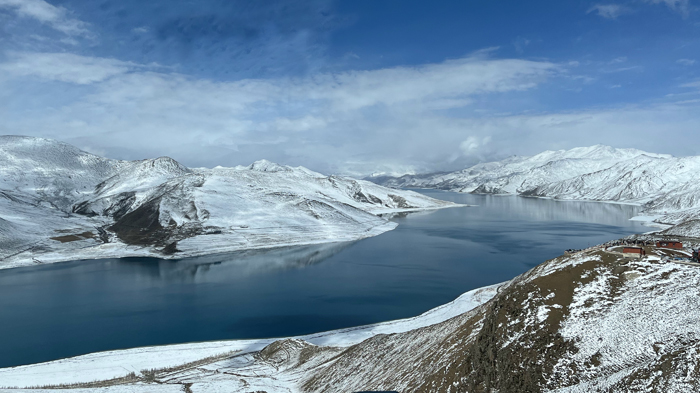 Yamdrok Lake with snow mountains around
Yamdrok Lake with snow mountains around
Shishapangma on the Way from Lhasa to Kathmandu
Located on the way from Lhasa to Kathmandu, Shishapangma is part of the Himalayan mountain range and stands near the border with Nepal. Shishapangma is the 14th highest mountain in the world, with an elevation of 8,027 meters (26,335 feet) above sea level.
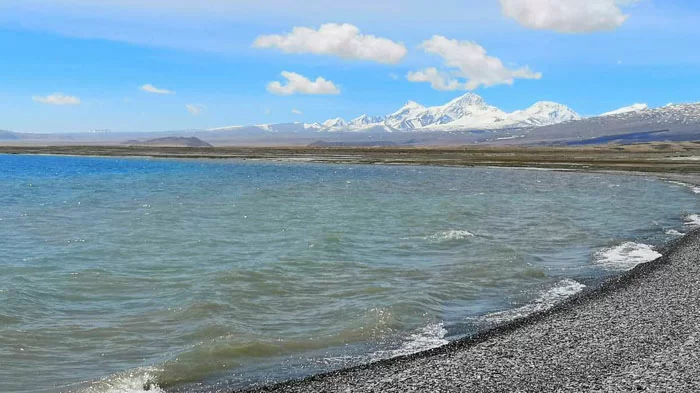 Mount Shishapangma and Peiku Tso Lake.
Mount Shishapangma and Peiku Tso Lake.
As you travel from Lhasa to Kathmandu, the route offers glimpses of Shishapangma, one of the world's 14 peaks above 8,000 meters. While you won't have an up-close view of the mountain itself, you can appreciate its distant snow-covered magnificence and towering presence among the Himalayan peaks. Shishapangma's majestic silhouette against the sky is a breathtaking sight, showcasing the grandeur of the world's tallest mountain range. The journey provides a unique opportunity to witness this natural wonder along with other stunning Himalayan scenery.
Namcha Barwa Peak in Nyingchi
Namcha Barwa Peak is a majestic Himalayan mountain in Nyingchi, Tibet. Known for its breathtaking beauty, it stands at 7,782 meters and is often shrouded in snow. The best way to see the snow-capped peak is by trekking or visiting viewpoints along the Yarlung Tsangpo Grand Canyon, offering stunning vistas of this iconic natural wonder..
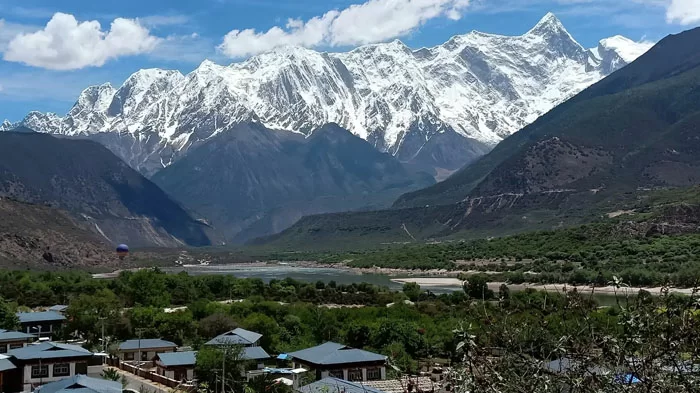 Nyingchi Namcha Barwa Peak.
Nyingchi Namcha Barwa Peak.
Recommended Tibet Tour Itineraries to Enjoy the Snow in Tibet
If you are planning a Tibet winter tour for the snowy landscapes, then there are certain places you can visit that will give you the best possible chance of seeing snow. Tibet may be called the “Land of Snows”, but it does not always snow on schedule, and there are times when there is no snow, despite it being cold enough or late enough in the year to expect it.
8 Days Lhasa to Everest Base Camp Tour
The Tibet Everest Base Camp, situated at approximately 5,200 meters, sees snowfall from mid-November to April, creating an iconic wintry landscape. The classic 8-day Lhasa to Everest Base Camp Tour offers a gradual altitude adjustment with two days in Lhasa. The journey continues along the Friendship Highway, passing Gyantse and Shigatse for visits to Yamdrok Lake, Gyantse Kumbum, and Tashilhunpo Monastery. Rongbuk Monastery, near Everest Base Camp, provides an overnight stay with sunset views of Mount Everest, followed by a visit to the base camp the next morning. This itinerary is ideal for acclimatizing and capturing Tibet's snowy Everest vistas.
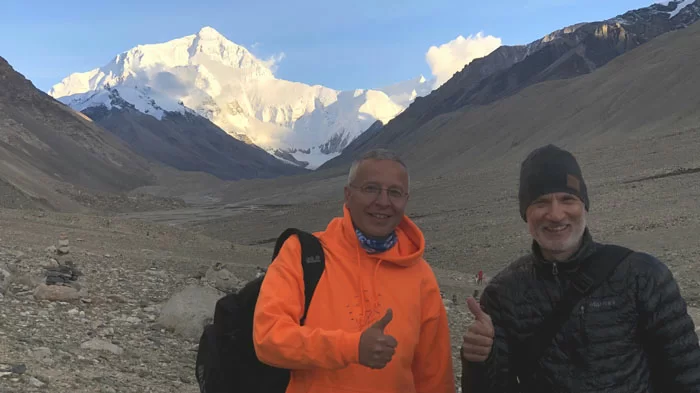 Tibet Everest Base Camp tour.
Tibet Everest Base Camp tour.
5 to 6 Days Lhasa to Yamdrok Lake/Shigatse Tour
If you are seeking a short Tibet tour to enjoy the snow in winter, here are two recommended itineraries: Lhasa to Yamdrok Lake (5 days) and Lhasa to Shigatse (6 days).
For the 5-day tour, you will visit Lhasa, then head to Yamdrok Lake, a beautiful alpine lake with snowcapped mountains in the background. On the way, you will also see the traditional Tibetan villages.
If you can spare an additional day, consider continuing your journey from Yamdrok Lake to Shigatse, the second-largest city in Tibet. Explore the famous Tashilhunpo Monastery and relish the stunning beauty of the Tashilhungpo Valley. During winter, the monastery's snow-covered splendor adds an extra layer of enchantment to your experience.
10 to 15 Days Mount Kailash Tour
Mount Kailash, in Ngari Prefecture in the west of Tibet, is renowned for having snow around it in the winter months. The trek around the Mount Kailash kora route can still be done in from mid-April to mid-Oct, though it's summer due to the high altitude, it can snow heavily around the mountain without notice.
One of the best places to trek and see snow-covered landscapes, Mount Kailash is an unforgettable adventure. If you plan to visit Mount Kailash from Lhasa, it may take 15 days; If you travel from Kathmandu to Mount Kailash, it will take 10 days by land . Both tours are not available in winter.
One Week Lhasa to Kathmandu Overland Tour
The epic overland journey from Lhasa to Kathmandu, or vice versa, is the best way to enjoy the snow-capped mountains of the Himalayan. During the Tibet Nepal tour, you will travel through the Himalayas and stay overnight at Everest Base Camp in Tibet to closely appreciate the marvelous view of the summit of Mount Everest.
2 Days Lhasa to Namtso Lake Tour
If you're looking for a natural side trip around Lhasa city to enjoy the snow, consider the Lhasa to Namtso Lake tour. This 2-day trip takes you to Namtso Lake, a beautiful alpine lake surrounded by snowcapped mountains. The tour is not recommended during January and February due to heavy snowfall. Otherwise, it's an ideal choice for experiencing the beauty of Tibet's snowy landscapes.
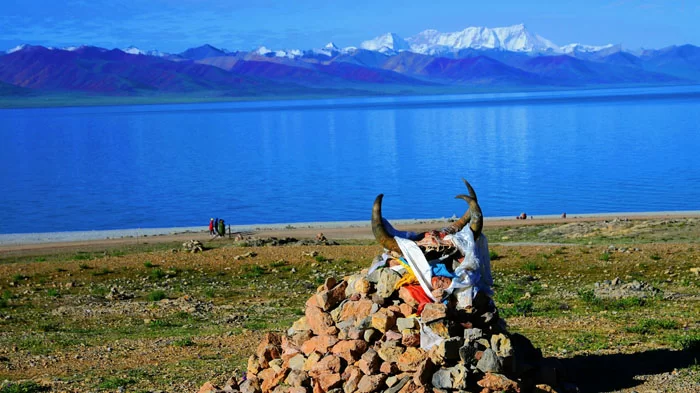 Nyenchen Tanglha Mountains surrounding Lake Namtso.
Nyenchen Tanglha Mountains surrounding Lake Namtso.
10 Days Nyingchi Tour
In the early part of spring in Nyingchi Prefecture in the east of Tibet, there is a good chance of seeing snow on the ground, especially in the higher areas of the prefecture on the slopes of the mountains.
Late March to April is the time of the Nyingchi Peach Blossom Festival, and if you can get there early enough, you can get to see the peach blossoms bursting forth from beneath snow-clad branches. Although the area is one of the lowest in Tibet in terms of altitude, the winter produces a fair amount of snow, except in the very lowest of valleys.
More Travel Tips for Enjoying Snow in Tibet when Visiting Tibet
Here are more travel tips for you to have a comfortable Tibet tour while enjoying the snow in Tibet.
Sun Protection: The sun's rays can be reflected by the snow, causing severe eye strain. Wear sunglasses to protect your eyes from snow blindness.
Stay Warm: The temperature can drop rapidly when the snow falls. Bundle up in warm clothing to prevent freezing and catch a cold.
Proper Footwear: Your feet will be walking on snow, so choose shoes or boots that are suitable for snow, keeping your feet warm, supported, and dry.
Prepare for Unexpected Weather: Snowstorms can cause road closures in winter. Have a Plan B ready in case you need to detour or face any other unexpected situation.
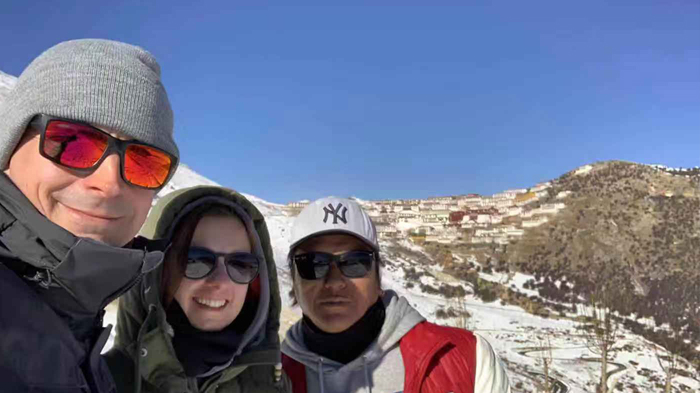 Make a good preparation for Enjoying Snow in Tibet
Make a good preparation for Enjoying Snow in Tibet
Conclusion
Tibet's snowy landscapes offer a magical winter experience. The best time to enjoy snow in Tibet is typically from November to April, with the heaviest snowfall occurring in December and January. Central and western Tibet are the snowiest regions, with Everest Base Camp being a top destination. Other recommended places include Lhasa city and Lake Yamdrok.
If you wish to see snow during other times of the year, consider visiting Mount Everest or Mount Kailash. Additionally, there are mountains with year-round snow, such as the Nyechen Tanglha Mountains near Lake Namtso, Mount Nojin Kangtsang near Lake Yamdrok, Shishapangma on the route from Lhasa to Kathmandu, and Namcha Barwa Peak in Nyingchi.
Feel free to contact us to customize your own itinerary for exploring the snowy landscapes or join one of our Tibet small group tours to the best destinations with snow-capped mountains in Tibet.

I am a tour guide in Tibet an was Born in Kham Tibet, I am the father of 2 little girls, bachelor's degree. I have more than 7-years experience of being a tour guide in Tibet. I am a warm, friendly, knowledgeable and attractive guy.
Related Articles & Posts
Most Popular Tibet Tour Packages
-

Lhasa - Gyantse - Shigatse - Everest Base Camp - Shigatse - Lhasa
USD939
View Details -

Lhasa - Gyantse - Shigatse - E.B.C - Saga - Kailash Trek - Darchen - Lake Manasarovar - Saga - Gyirong - Tingri - Lhasa
USD2059
View Details -

10 Days Lhasa to Everest Base Camp and Namtso Lake Small Group Tour
Lhasa - Gyantse - Shigatse - EBC - Shigatse - Lhasa - Namtso Lake - Damxung - Lhasa
USD1289
View Details -

8 Days Driving Across Himalaya Overland Adventure from Kathmandu to Lhasa
Kathmandu - Gyirong - Everest Base Camp - Tingri - Shigatse - Gyantse - Lhasa
USD1069
View Details -

4 Days Lhasa Impression Small Group Tour: Explore the Heart of Tibet and Mingle with the Locals
Lhasa
USD509
View Details -

Lhasa - Gyantse - Shigatse - Everest Base Camp - Gyirong - Kathmandu
USD979
View Details -

Lhasa - Gyantse - Shigatse- Lhasa
USD799
View Details -

13 Day Lhasa, Mt. Everest, Mt. Kailash, Lake Manasarovar and Kathmandu Adventure Tour
Lhasa - Gyantse - Shigatse - EBC - Saga - Darchen - Kailash Trek - Darchen - Saga - Gyirong - Kathmandu
USD2059
View Details


.jpg)



